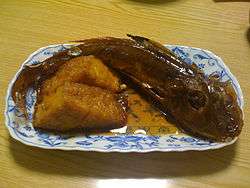Nimono
|
Nishime, a nimono of various vegetables (including bamboo shoot, lotus root and shiitake) prepared in southern Aomori Prefecture | |
| Course | Side dish |
|---|---|
| Place of origin | Japan |
| Region or state | Japanese-speaking areas |
| Main ingredients | Vegetable or seafood, dashi, sake, soy sauce, mirin |
| Similar dishes | Jorim |
| |
Nimono (煮物) is a simmered dish in Japanese cuisine. A nimono generally consists of a base ingredient simmered in shiru stock flavored with sake, soy sauce, and a small amount of sweetening. The nimono is simmered in the shiru over a period of time until the liquid is absorbed into the base ingredient or evaporated. The base ingredients for a nimono is typically a vegetable, fish, seafood, or tofu, either singly, or in combination. The shiru stock for a nimono is generally dashi. Other than sake and soy sauce, the stock can be further flavored by mirin, sugar, salt, vinegar, miso, or other condiments. A heavy covered pot is used in making nimono in order to spread the heat evenly throughout the ingredients during the simmering process.
Types
- Misoni (味噌煮), also misodaki (味噌炊き): fish, but sometimes vegetables, simmered in a mixture of miso and dashi[1]
- Nikujaga (肉じゃが): beef and potato stew, flavoured with sweet soy
- Nizakana (煮魚): fish poached in a broth of sweetened dashi, sometimes with miso, also referred to as nitsuke (煮付け). The dish first appears in cookbooks in the early 18th century[2]
- Kakuni (角煮): chunks of pork belly stewed in soy, mirin and sake with large pieces of daikon and whole boiled eggs. The Okinawan variation, using awamori, soy sauce and miso, is known as rafuti.
- Sōki (ソーキ): Okinawan dish of pork stewed with bone
- Oden (おでん)
- Nabemono (鍋物)
See also
References
Bibliography
- Hosking, Richard (2000). At the Japanese Table. Images of Asia. New York: Oxford University Press. ISBN 978-0-195-90980-7. LCCN 00058458. OCLC 44579064.
- Ashkenazi, Michael; Jacob, Jeanne (2000). The Essence Of Japanese Cuisine: an Essay On Food And Culture. Richmond, Surrey: Curzon. ISBN 978-0-700-71085-0. OCLC 44937736.
This article is issued from
Wikipedia.
The text is licensed under Creative Commons - Attribution - Sharealike.
Additional terms may apply for the media files.

